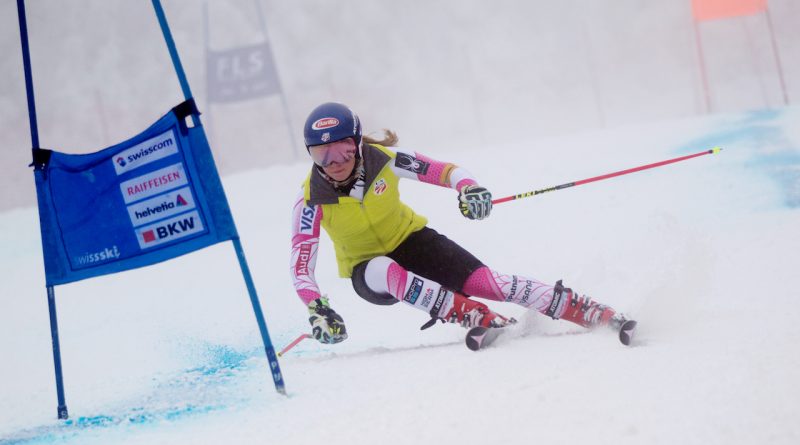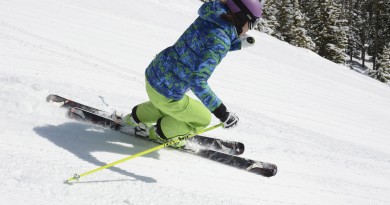Born From Ice: On Skiing The Slick Stuff
If you can ski or ride Eastern ice, you can handle anything. So here’s how to manage the slick stuff.
“Born from Ice” is the tagline for Ski the East, Vermont’s homegrown apparel and rad ski movie company. It’s true: ice is in our DNA here, and it defines us as skiers and riders.
While we surely have days full of deep white powder, the bulk of what we do is shred on the firm stuff. This solid base literally and figuratively creates a foundation for our skiing skills. Anyone can ski or ride soft, grippable snow, but it takes skills to keep your stuff together on the firm and shiny. Since we know that these conditions are going to be a part of our early season, it’s a good idea to get your head and your gear, ready. These are my five best tips to be ice-ready.
1. Avoid the Slick Stuff
While making good turns on ice is important, it is sometimes easier to avoid the slick spots altogether. Getting your butt out of bed early and being on the hill first thing is one of the best ways to find a better surface. After a few hours on a crowded mountain, the light granular from last night’s grooming gets scraped off, revealing some serious ice in a lot of the popular locations. This gets amplified if there hasn’t been any natural snow in a while. So, pick your days and get out early to minimize your time on ice.
2. Don’t Brake, Turn!
You still end up riding some ice. So what do you do? Well, racers ski ice all the time, and it doesn’t freak them out. Why is that? For one, they aren’t trying to put on the brakes while skiing. If you ask recreational skiers or snowboarders why they turn, they will usually say to slow down, or to brake. Racers are turning in a race course to go across the hill and make the next gate. Turning doesn’t need to mean braking. We, too, can use our turns to take our energy across the hill and maintain flow and speed. Continuing to move and trying to go forward, instead of locking up and trying to stop, is key to handling ice well.
For skiers, one good indicator is your pole swing. If you are making short turns and slide over ice, do you keep moving? Do you keep your skis tipping and turning? If you keep swinging your poles, you will usually keep turning your legs. Try to keep your poles moving the next time you make turns over an icy patch and see how this affects your legs and your skis.
3. Lay it On Edge
While you keep your hands and legs moving over the ice, it’s also important to be getting the skis or board on edge. The flat bottoms of skis or boards are meant to slide and the metal edges are like knives that can cut into the surface and help set your course.
As East Coasters, we ski with a lot higher edge angle to effectively maneuver icy conditions. This requires a little wider stance, and the ability to roll your boots so that you can tip the skis on edge.
The timing of when you edge is another important component. Too many skiers put their edges to work too late in the turn. The next time you are on the hill, think about what direction the bottoms of your skis are facing. Are you making turns that show the bottoms of your skis to people down at the end of the run, or do you show the bottoms of your skis to someone standing on the side of the trail? If you can start to show the bottoms of your skis to the sides of the trail, and less to the people at the end of the run, you will get on an earlier edge, and carve through ice a lot easier. This will also create a turn that is less focused on braking, and more on going across the hill. This carving of the skis will also lend itself to faster skiing, and is the best way to operate on firm snow.
4. Use the Right Tools
While all skis will carve a turn, some skis (and boards) are better at it and can make you the boss of ice. If you find that you spend more time on groomed (and sometimes icy) surfaces than you do on soft snow or off piste, get yourself the right tool for the job.
Modern “all-mountain” skis are a little more focused on doing everything, but there are still skis that excel on the firm trails of the East. Any race ski will be ready for ice, but you can also get a recreational carver that will do the trick. These skis have less rocker in the tip and little rocker in the tail. They also have a little extra side cut. That means that when you are on a high edge angle, riding the carve, they will come around a little faster so you don’t have to break out of the carve and skid your turns. A good carving ski will also be a little narrower (think 85mm underfoot or less) to get from edge to edge more quickly.
5. Sharpen Up!
Now, even a ski that is all about edging is going to need to have a sharp edge. As a quick crash course in tuning: your skis have a side edge and a base edge. The base edge is the part of the metal edge that sits on the snow when you set your skis down. The side edge is the part of the ski that only hits the snow when the ski is tipped up. The side edge is what needs to be sharp to hold on ice. When you tune your skis at a shop, they will sharpen both parts of the edge, but the side edge is more important for handling ice. By increasing the bevel, or angle at which the side edge is sharpened, you can create an edge that holds even better on ice. The downside is that a more beveled edge will dull faster, and will require more maintenance to stay sharp.
Most recreational skis will come with a base bevel of 1 degree and a side bevel of 2 degrees. This is a decent starting point, but if you really want a ski to be ice ready, then a 3 degree side bevel will add some serious grip. A tune and wax at a shop is usually $30 or $40, and they can do whatever bevels you would like. A good tune will usually hold on firm snow for four or five days if you don’t bounce off too many rocks, but with a higher side edge bevel, you may lose a day or two, and that’s when it pays to do your own maintenance.
I’ve always believed that carving a good turn is essential to being an expert skier, and it is a critical skill for skiing ice. Take these tips to heart, and make this the season that you step up your game and ski the firm.
Doug Stewart, an examiner for the Eastern Division of the Professional Ski Instructors of America, is a bootfitter at Skirack in Burlington. He also teaches skiing and trains the ski school staff at Stowe Mountain Resort.



